Kris Gopalakrishnan, co-founder of Indian information technology giant Infosys, stares out from a wall-to-wall poster in a modern office building near Kochi, in the southern state of Kerala.
A caption reads: “We started Infosys in a room about this size; it’s your turn now.”
His message is directed at aspiring entrepreneurs at Startup Village, a state-of-the-art glass and steel edifice tucked in a green corner of the port city, who dream of creating the next billion-dollar tech giant.
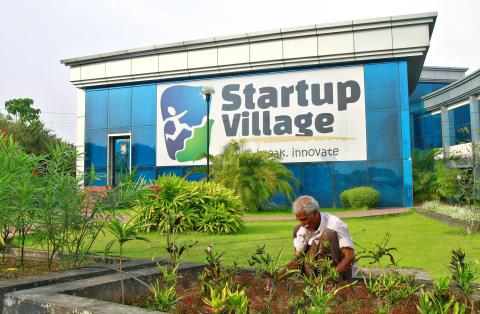
Photo: Reuters
But even three decades after Infosys, India’s second-largest software service provider, was founded by middle-class engineers, the country has failed to create an enabling environment for first-generation entrepreneurs.
Startup Village wants to break the logjam by helping engineers develop 1,000 Internet and mobile companies in the next 10 years. It provides its members with office space, guidance and a chance to hobnob with the stars of the tech industry, including Gopalakrishnan, the project’s chief mentor.
But critics say this may not even be the beginning of a game-changer unless India deals with a host of other impediments — from red tape to a lack of innovation and a dearth of investors — that are blocking entrepreneurship in Asia’s third-largest economy.
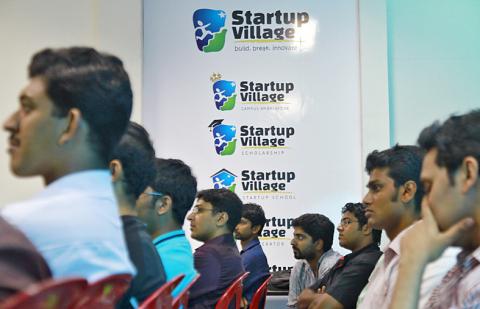
Photo: Reuters
India ranks 74th out of 79 nations in the Global Entrepreneurship and Development Index, making it one of the worst places in the world to start a business.
A World Bank report says it is easier to start a business in violence-afflicted Pakistan or poverty-stricken Nepal than in their giant neighbor, where everything from getting electricity to credit is time-consuming and fraught with paperwork.
“Take Apple or take Google. If exactly the same company had been started in India, its prospects would have been very different,” said Erkko Autio, chair in technology venturing and entrepreneurship at Imperial College, London. “Basically, it would have not reached the potential it has as a start-up.”
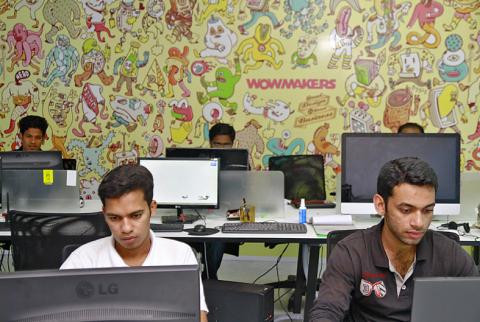
Photo: Reuters
Indian-born entrepreneurs have been enormously successful in the US, where they have the highest number of tech-start-ups by any immigrant group. But India has not been able to build itself a community like Silicon Valley where there is easy access to equity, a pool of creative talent and first-world infrastructure.
“We were alone. We had no idea how to make a company, how to sell it ... We tried, failed, tried, failed,” said Kallidil Kalidasan, a 23-year-old member who started a mobile app venture in Kerala two years ago and could not find a single investor.
He is now one of the entrepreneurs at Startup Village, and is working on a product that could help the government detect illegal abortions in a country plagued by female foeticide.
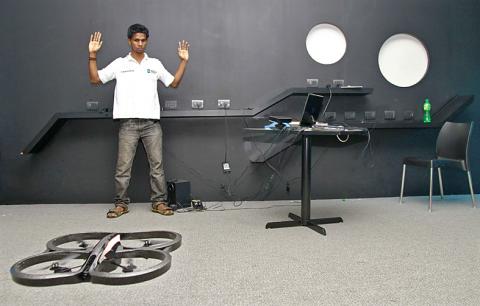
Photo: Reuters
BARE NECESSITIES
The seven-month-old Startup Village provides would-be entrepreneurs with workspace at rents about a tenth of anywhere else in Kochi, computers, a high-speed Internet connection, legal and intellectual property services and access to high-profile investors.
The village is still to be completed, but 68 people, would-be entrepreneurs and their teams, have already taken up two buildings at the site.
Spread over 9,250 square meters — equivalent to 20 basketball courts — Startup Village will be completed in 2014. India has 120 other incubators, but they are mostly housed in academic institutions and have not drawn a strong network of advisers from the private sector.
Startup Village, the first such institution to be jointly funded by the government and private sector, has Gopalakrishnan as its chief promoter and has collaborations with companies such as BlackBerry maker Research in Motion and IBM.
“One, the goal of this initiative is to create new companies and create jobs. Second, this will create new solutions and products,” Gopalakrishnan told Reuters in an e-mail interview.
He is excited about creating an ecosystem for entrepreneurs in his home-state, Kerala, which is famous for its tropical coastline and backwaters. The Village team says it chose Kerala because costs are lower than New Delhi or Mumbai and it has 150 engineering colleges that can provide start-up enthusiasts.
But for some, Startup Village will not work because it does not provide the right environment for a budding tech start-up.
“What does an entrepreneur need besides money? They need strong support in terms of advice,” said Mukund Mohan, who has founded and sold three Silicon Valley start-ups and is CEO-in-residence at the Microsoft Accelerator. The institution helps start-ups in Bangalore, the city most associated with India’s software industry that is about 550km north of Kochi.
“There are not that many entrepreneurs in India, and there are hardly any in Kerala who have the expertise to be able to build, scale and sell strong software companies,” said Mohan. “If you have not been there and done that before, what advice will you give?”
But Bangalore has not been able to nurture a start-up culture of any significance either. It has many aspiring CEOs and optimistic financiers, but they are also struggling with a maze of regulations and half-hearted government support.
LACK OF INGENUITY
The newer start-ups in Bangalore or Kerala are eying products not services. Many bring ideas catering to the booming market of domestic online shoppers, like Flipkart, the nation’s most heavily financed e-commerce company. But financial backers for such ventures are few and far between.
“We are a fixed-deposit country,” said Rajesh Sawhney, founder of GSF Superangels that provides angel and seed funding to start-ups. “Our investors are risk-averse. They don’t trust young people with their money.”
Fewer than 150 start-ups are promoted by venture capital or angel investors annually in India. There are over 60,000 angel investments, made in the early stages of a start-up, alone per year in the United States, according to an Indian government report.
Experts believe India is handicapped by a lack of ingenuity. It ranks 64th on the Global Innovation Index, much below other BRICS nations. Indian graduates, largely trained in services, have difficulty innovating beyond that approach.
Barely 700 technology product startups are launched every year in India versus over 14,000 in the United States, according to the Microsoft Accelerator database.
For India’s risk-averse middle-class, entrepreneurship is the last recourse of the unemployed.
“If you go to a function, and someone asks you where you are working, and if you don’t say Infosys or Wipro, they say: ‘Oh you did not get placement (for a job),’” said Startup Village member Sreekumar Ravi.
Ravi is working on creating an affordable multi-touch computing surface that could change the way people window shop in malls or place orders in restaurants.
Startup Village aims to pluck innovators from college campuses, and bring them into the fold after evaluating their business ideas. Many of its in-house entrepreneurs are in their mid-twenties.
But critics are sceptical if Startup Village would be able to launch the next Infosys in India — or even be successful in its goal of incubating 1,000 online companies.
“I will be thrilled if they do even a quarter of that number ... But do I think they will do more than 100? No.” said Mohan from Microsoft Accelarator. “I mean I hope they succeed. But hope is not a strategy, hope is only a prayer.”

April 28 to May 4 During the Japanese colonial era, a city’s “first” high school typically served Japanese students, while Taiwanese attended the “second” high school. Only in Taichung was this reversed. That’s because when Taichung First High School opened its doors on May 1, 1915 to serve Taiwanese students who were previously barred from secondary education, it was the only high school in town. Former principal Hideo Azukisawa threatened to quit when the government in 1922 attempted to transfer the “first” designation to a new local high school for Japanese students, leading to this unusual situation. Prior to the Taichung First

Chinese Nationalist Party (KMT) Chairman Eric Chu (朱立倫) hatched a bold plan to charge forward and seize the initiative when he held a protest in front of the Taipei City Prosecutors’ Office. Though risky, because illegal, its success would help tackle at least six problems facing both himself and the KMT. What he did not see coming was Taipei Mayor Chiang Wan-an (將萬安) tripping him up out of the gate. In spite of Chu being the most consequential and successful KMT chairman since the early 2010s — arguably saving the party from financial ruin and restoring its electoral viability —

The Ministry of Education last month proposed a nationwide ban on mobile devices in schools, aiming to curb concerns over student phone addiction. Under the revised regulation, which will take effect in August, teachers and schools will be required to collect mobile devices — including phones, laptops and wearables devices — for safekeeping during school hours, unless they are being used for educational purposes. For Chang Fong-ching (張鳳琴), the ban will have a positive impact. “It’s a good move,” says the professor in the department of
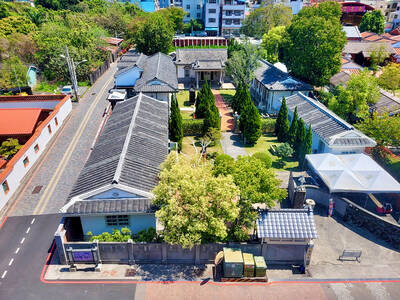
Toward the outside edge of Taichung City, in Wufeng District (霧峰去), sits a sprawling collection of single-story buildings with tiled roofs belonging to the Wufeng Lin (霧峰林家) family, who rose to prominence through success in military, commercial, and artistic endeavors in the 19th century. Most of these buildings have brick walls and tiled roofs in the traditional reddish-brown color, but in the middle is one incongruous property with bright white walls and a black tiled roof: Yipu Garden (頤圃). Purists may scoff at the Japanese-style exterior and its radical departure from the Fujianese architectural style of the surrounding buildings. However, the property